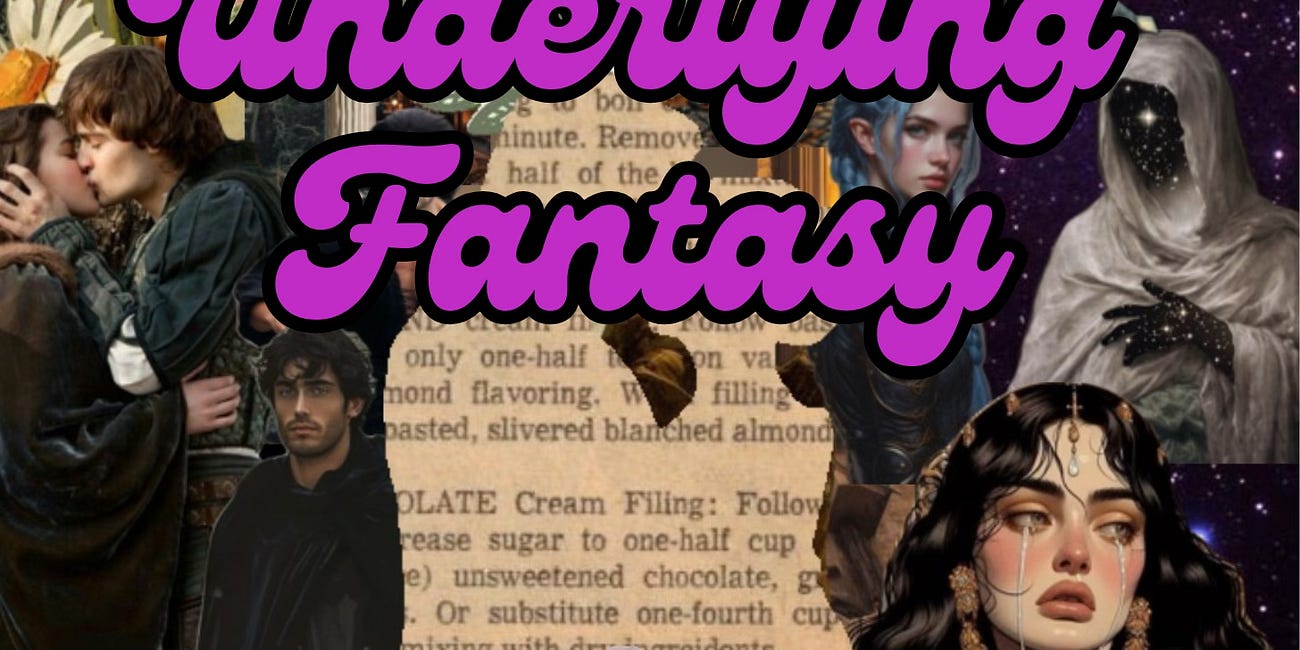Putting Your Characters Through Hell✨
How to create plot vacuums that torture your characters--and keep your readers turning the page.
welcome to character hell 🔥
justice vacuums ⚖️
nurture vacuums 🧑🏼🍼
emotional vacuums 🫂
final notes on vacuums 🧹
resources/fact check 📋
1. welcome to character hell🔥
Hallo, dear readers, and welcome to Character Hell. Hear that strange yet powerful sucking noise? Notice anything unusual about your surroundings? Like how there’s absolutely nothing here? That’s because… BOOM! You’re in a vacuum! (Do vacuums go boom? We’re not physicists).
A vacuum is a space that is completely devoid of all matter. It’s a negative force, with such low pressure, it sucks you right in because the universe demands that you fill it. We first talked about vacuums as a craft element a few weeks ago, in our Underlying Fantasy episode (when we first discovered 7 Figure Fiction). Here, we expand upon the three vacuums the author, T. Taylor, mentioned. Our goal is to explore how to use these negative pressure zones to compel readers to keep reading. Let’s dive in!
2. justice vacuums⚖️
Justice vacuums are, as T. Taylor says, “when a [main character] is treated so unfairly in the beginning, we must keep consuming the story until justice is served in the end.” When we read stories with latent justice vacuums, we are absolutely boiling from the lack of justice. And what do readers do with that frustration? Why, they keep on reading, of course! Just as the universe decrees that vacuums suck neighboring matter into them, balancing that negative pressure until it is satisfied, your plot will suck your reader into it, desperate to see the scales of justice balanced. And they won’t stop until they’re satisfied.
This is one of those super powerful craft techniques that unconsciously pulls your reader, often driving them to excuse all other reasons to put the book down because they just need to see what happens next (namely, that justice is served). It’s happened to all of us! Perhaps you can think of a book or other media that you really didn’t want to like, or maybe even wanted to stop reading/turn off, but you just needed to see what happened next. If that wasn’t a justice vacuum, it was likely another vacuum we’ll mention today.
In the podcast episode that accompanies this newsletter, we go through several examples of justice vacuums, from middle grade through adult. We strongly encourage you check this one out, as this is definitely a concept we learned through examples.
But for the sake of this newsletter, let’s point you to a few famous examples of justice vacuums that appear right at the start of a story (where they should be):
Cinderella. She’s her noble father’s daughter! She’s no servant! Yet she’s responsible for WAY too many chores, and they don’t even say thank you! So we keep reading/watching until that evil stepmother and her awful spawn learn their lesson.
Speaking of Disney, how about Simba from the Lion King? First, his uncle kills Simba’s father, and then, he convinces Simba that it’s his fault, not only causing him to exile himself (and for everyone to think he’s dead), but also giving Scar the opportunity to become the evil lion king who ruins all that is good about the land. And Scar GETS AWAY WITH IT! That’s particularly good craft; it would have been compelling enough to craft a plot in which Simba is exiled and Scar makes a power grab, but for Scar to orchestrate the entire thing and get away with murder means the scales of justice are uncomfortably out of whack for much of the film, and we must keep watching to see them righted again.
Harry Pottah. Yet another orphaned child who is treated like a servant and not a family member. He sleeps in a cupboard, not even a bedroom! They say awful things about his dead parents! They won’t even let him go to wizard school, even though that’s what his parents wanted! So we keep reading to see this poor little boy finally catch a break.
There are plenty more examples outside of kid lit and fairy tales. Feel free to share the ones that come to mind for you in the comments! In the mean time, let’s move on to….
3. nurture vacuums 🫂
Nurture vacuums are exactly like justice vacuums, except what’s missing is the nurture your character desperately needs. While justice vacuums are more about unfairness, nurture vacuums are more about an absolute void of caretaking. There will be plenty of overlap (Cinderella, for example, was not exactly being nurtured by her stepmother, leading to her fair godmother and mice to step in). But nurture vacuums also exist separate from justice vacuums. They lean into the sadness of neglect, of having a need overlooked, and can range from the subtle to the blatant. Wherever your nurture vacuum falls on the scale, it’s going to pull right at your character’s hearts until they’re screaming, “SOMEONE GIVE THAT POOR GIRL A HUG.”
Once again, we spend quite a bit of time dissecting nurture vacuums using some of the stories we’re most addicted to, but here are a few others to elucidate the point:
Bella Swan. The mc of Twilight has two loving parents, so this is a subtle one. But her father (who is now our favorite character, but this point remains) has the emotional intelligence of a beetle at the start of the story, and he can hardly check in on her without cringing with discomfort. She cooks his dinners, makes sure he eats his vegetables, and stays out of trouble so he doesn’t worry (except the whole falling in love with a vampire thing). And her mother is off with her boyfriend. We learn on page one that Bella is more the parent than her mother, and that she is taking care of mom’s emotional needs by moving to Forks and getting out of her way. On some unconscious level, we’re screaming for someone to look after Bella. Enter the hot vampire who will watch over her ALL. THE. TIME.

Daryl Dixon on The Walking Dead: Including this one because it’s an interesting twist on the typical vacuum. Fans of TWD absolute LOVE Daryl. We all wanted to give him a hug and some hot soup. Even at the start of the show, we see all of his deserving characteristics (like his loyalty and toughness). But we’re drawn to love him well beyond the fact that he’s relatable. Daryl never explicitly explains what life was like for him before the Zombie Apocalypse, but it’s safe to assume he was badly neglected. He has zero idea how to express his feelings in words (though he does it through working hard for the people who matter to him). He is quiet, as if he doesn’t expect people to listen to him. He goes out of his way to keep children safe without looking for accolades for doing so. And Norman Reedus, the actor who played him, mastered the facial expressions of someone who desperately wants love but will never ask for it, not in a million years. Eventually, we discover that he was severely abused and neglected as a child, and had to fend for himself at a young age, but the vacuum pulls us in long before we know his backstory, which is good writing (and fantastic acting) at its best.
We may be able to posit that every instance of the “grumpy person taking care of a child” trope leans into the nurture vacuum. The kiddo is all alone in the (dangerous) world, and their lack of nurture is such a powerful vacuum, the grumpalump has no choice but to begrudgingly step in. We see you, Joel from The Last of Us.
4. emotional vacuums
Once again, emotional vacuums are just like justice and nurture vacuums, only they refer to the specific emotional needs of your character. There’s still plenty of overlap—a character who is utterly devoid of the love they crave can also be experiencing injustice and neglect—but emotional vacuums allow you to get to the nitty gritty of what your character wants—and how devoid they are of it. Often times, an erotic romance is far more powerful when the main character has never experienced satisfying sex in her whole damn life. Or going back to our girl, Bella (where the hell have you been, loca?!), she has a quiet nurture vacuum, as discussed above, but she also has an overlapping emotional vacuum. Let’s dive in with a few examples to drive the point home, starting with Bellz.

In Twilight, every single early scene (before Edward actually talks to her) highlights how no one is emotionally attuned to Bella. She’s uncomfortable in her own skin, yet everyone at school throws their arms around her as if A- they’re best friends, and B- she’s not absolutely brand new to this school, and C- she’s not cringing at their touch. For a long time, they all call her Isabella, and they talk over her. At home, Hot Dad Charlie isn’t much better, bc he’s too emotionally stunted (FOR NOW) for a father-daughter heart-to-heart. The girl is desperate for someone to listen to her and to ask the right questions, and as the readers, we’re desperate to see it, too. Enter Edward.
How about Walter White from Breaking Bad? This subtle but powerful use of an emotional vacuum thrusts the viewer into rooting for him to do objectively awful things. Sticking to the first episode early (no spoilers, but you really need to watch), we learn Walt is diagnosed with a scary form of lung cancer. Poor Walt, but this vacuum isn’t enough. He also doesn’t have the money for expensive treatments that might save his life. Poor Walt, but still, this vacuum isn’t enough. We see nearly every one in Walt’s life walk over him. And herein lies the Hoover of emotional vacuums: The man is desperate for respect. But he’s so nice and unassuming, everyone walks all over him. His students certainly don’t give him any respect, despite his brilliance. His wife talks over him 90% of the time, even when it’s about his own mortality. His son worships his macho uncle instead of his loving father. Unless something changes, Walt’s going to die just as he lived: as a complete and utter doormat. By the time he starts cooking meth in his tighty whites to pay for his own damn treatments, we are 100% on board. Anything to get this man some much-needed respect, filling the vacuum we can’t tolerate.

5. final notes on vacuums
A few nuggets of insight we’re chewing on:
Good vacuum conditions are built on believable reasons WHY. Your characters can’t just be mistreated by random strangers for the hell of it. The circumstances—and the offending characters—need to be fleshed out and believable.
Good vacuums are character consistent. They highlight aspects of your character’s journey that are at the heart of your story.
Good vacuums are most powerful when they occur to people we like. We are most impacted by the suck of a vacuum when we really care about the person experiencing it, and want to root for them!
Flickers of hope are a powerful way to highlight a vacuum—just before the vacuum snuffs that light out. Maybe your character makes a friend, only for them to turn against them. Or reaches out to a teacher, only to be snubbed or overlooked. The more we picked apart vacuums this episode, the more we stumbled upon flickers of hope.
Not every story needs a vacuum. We repeat: NOT EVERY STORY NEEDS A VACUUM. This is but one of many powerful craft techniques that make for an un-put-downable story. Don’t worry; there are plenty of other ways to put your characters through hell.
4. resources/fact check 📋
Once again, we are referring the heck out of Seven Figure Fiction by T. Taylor. This entire concept was coined in this book and its companion book.
Lyssa called Moldemort the richest woman in the world. She is not, though she’s the richest author in the world.
If you enjoy this topic, you’ll most definitely enjoy this related TTS episode:
(And if you’re wondering if we’re frustrated to no end on how it cut off our graphic, why yes. yes we are).
Thanks for listening and/or reading! And if you happen to be reading this as a forwarded email from a friend, might we convince you to subscribe and let us know you’re out there? We love you!











Vacuums, sadly, do not go boom because there is nothing to carry sound waves. So it’s more of a dying gasp into inexorable silence. Which, coincidentally, is the sound readers make when you have a great plot vacuum haha
Yay! Missed ya'll last week.